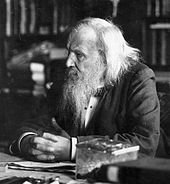Chemistry

Dmitri Mendeleev
Modern chemistry emerged from the sixteenth through the eighteenth centuries through the material practices and theories promoted by alchemy, medicine, manufacturing and mining. [135] A decisive moment came when 'chemistry' was distinguished from alchemy by Robert Boyle in his work The Sceptical Chymist , in 1661; although the alchemical tradition continued for some time after his work. Other important steps included the gravimetric experimental practices of medical chemists like William Cullen, Joseph Black, Torbern Bergman and
Pierre Macquer and through the work of
Antoine Lavoisier (Father of Modern Chemistry ) on oxygen and the law of
conservation of mass , which refuted
phlogiston theory. The theory that all matter is made of atoms, which are the smallest constituents of matter that cannot be broken down without losing the basic chemical and physical properties of that matter, was provided by John Dalton in 1803, although the question took a hundred years to settle as proven. Dalton also formulated the law of mass relationships. In 1869, Dmitri Mendeleev composed his periodic table of elements on the basis of Dalton's discoveries.
The synthesis of urea by Friedrich Wöhler opened a new research field, organic chemistry , and by the end of the 19th century, scientists were able to synthesize hundreds of organic compounds. The later part of the 19th century saw the exploitation of the Earth's petrochemicals, after the exhaustion of the oil supply from whaling . By the 20th century, systematic production of refined materials provided a ready supply of products which provided not only energy, but also synthetic materials for clothing, medicine, and everyday disposable resources. Application of the techniques of organic chemistry to living organisms resulted in physiological chemistry , the precursor to biochemistry . The 20th century also saw the integration of physics and chemistry, with chemical properties explained as the result of the electronic structure of the atom. Linus Pauling 's book on The Nature of the Chemical Bond used the principles of quantum mechanics to deduce
bond angles in ever-more complicated molecules. Pauling's work culminated in the physical modelling of DNA , the secret of life (in the words of Francis Crick , 1953). In the same year, the Miller–Urey experiment demonstrated in a simulation of primordial processes, that basic constituents of proteins, simple amino acids , could themselves be built up from simpler molecules.
Chic article. I learned a lot of interesting and cognitive. I'm screwed up with you, I'll be glad to reciprocal subscription))
thanks my glorious friend